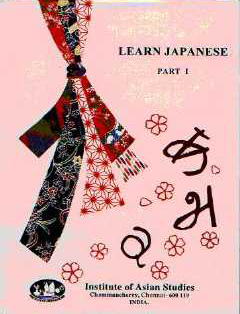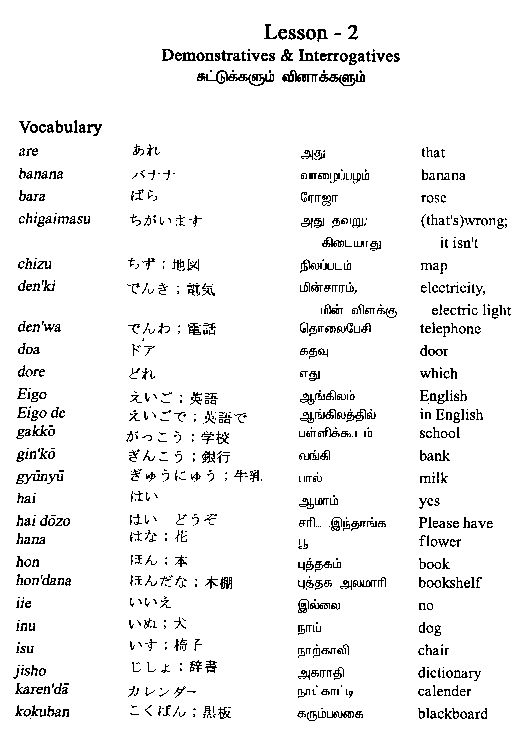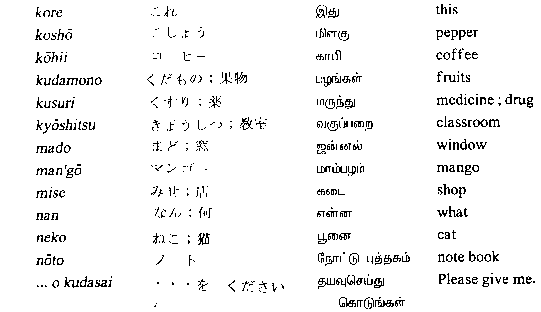Learn Japanese Part I
Learn Japanese Part II
Learn Japanese Part III
Similarities between Japanese and Tamil
Differences between Japanese and Tamil
Japanese language classes in Madras
The Department of Japanese is one of the pivotal departments which offers Japanese language courses at both beginner and advanced levels. Japanese teachers from Japan conduct classes together with Tamil-native teachers. This department is also credited with its publication of Japanese language textbooks, namely Learn Japanese Part I, Part II and Part III. The main purpose of this department is to introduce Japanese language and culture. The IAS library possesses some rare Japanese books including dictionaries, novels , encyclopaedia and teaching materials donated by the Japan Foundation. This department acts as an integral part of the institute to promote a good Indo-Japan relationship. Instructors of Japanese classes are :
- Ms. Yuko Fukuroi;
- Ms. Yuri Tachikawa; and
- Dr. V. Ganesan
COURSES IN JAPANESE LANGUAGE
Preparation for JLPT Examinations
The Institute of Asian Studies is starting the Japanese classes from 4th March 2009. The classes will be conducted by Japanese Professors with rich experience in teaching Japanese as a foreign language. The classes will be held in the evenings in Perungudi. Intensive training will be given to candidates appearing for the JLPT Examinations. The institute will restrict admission only to a limited number of candidates. Interested candidates may contact:
The Director,
Institute of Asian Studies,
Mobile: 9840526834
Learn Japanese language series produced by the IAS
NOTE: The Learn Japanese series will soon be available in CD-ROM version.
Learn Japanese Part I
General Editors: Dr. Shu Hikosaka and Dr. G .John Samuel
Advior : Dr. M. Shanmugam Pillai
Author : Yuko Fukuroi
October 1996, pp. xx+223
Learn Japanese Part I provides the basic course material for learning Japanese language through Tamil and also gives English explanation and translation for the benefit of the non-Tamils. It introduces foreigners to Japanese culture and life-style at the same time. It consists of ten lessons and eight appendices. Each lesson consists of vocabulary , illustrative sentences, conversation, grammar and exercise. Key to Exercises, lessons in Japanese and index are also appended. The Japanese portion in Roman script offers the original Japanese pronunciation for the readers. The book serves as a basic text for learning the Japanese language.
 Contents Contents
- How to Use This Text-book
- Japanese Alphabet - Hiragana & Katakana
- Lesson-1 Greetings
- Lesson-2 Demonstratives & Interrogatives
- Lesson-3 Demonstrative & Interrogative Pronouns
- Lesson-4 Honorific & Humble Expressions
- Lesson-5 Location Marker / Numerical Usage
- Lesson-6 Location and Time Markers
- Lesson-7 Adjective (1)
- Lesson-8 Adjective (2)
- Lesson-9 Non-Past and Past Tense / Time (2)
- Lesson-10 Case Marker / Adverbs
- Appendix-1 Honorific, Neutral & Humble Words
- Appendix-2 The Different Usage of ga and wa
- Appendix-3 Cardinal Numbers
- Appendix-4 Counters
- Appendix-5 Sound Combinations of Number and Counter
- Appendix-6 Specific Time
- Appendix-7 Period of Time
- Appendix-8 General Time
- Lessons in Japanese
Top Learn Japanese Part II
General Editors: Dr. Shu Hikosaka and Dr. G. John Samuel
Advior : Dr. M. Shanmugam Pillai
Author : Yuko Fukuroi
February 1997, pp. vii+281
Learn Japanese Part II,which is a continuation of Part I, is also meant for the beginners level. This book introduces mainly the -te form,the plain form of Japanese verbs and their usages. Apart from the ten lessons, this part includes a verb chart (which covers nearly three hundred verbs along with Tamil and English translations), and also introduces two hundred kan'ji. Japanese language consists of three scripts, namely Hiragana, Katakana and Chinese letters. The script borrowed from China is called kan'ji. Japanese language is written mostly with the combination of these three scripts. The kan'ji charts in this textbook provide the meaning, the stroke order and the usage of each kan'ji with example sentences. This part introduces a student to the spoken as well as the written form of the Japnese language.
Contents
- Lesson-11 Indefinite Pronouns / Various Usage of mo
- Lesson-12 Desiderative Form
- Lesson-13 Te-form of Verbs(1) Request
- Lesson-14 Te-form of Verbs(2) Progressive
- Lesson-15 Te-form of Verbs(3) Permission / Prohibition
- Lesson-16 Te-form of Verbs(4) Conjoining Predicates
- Lesson-17 Te-form of Verbs(5) Auxiliary Verbs
- Lesson-18 Plain Forms (1)
- Lesson-19 Plain Forms (2)
- Lesson-20 Koto- Nominalizer
- Verb List
- Lesson in Japanese
- Kanji Charts : 1-20
- Kanji Charts : Translations
Learn Japanese Part III
General Editors: Dr. Shu Hikosaka and Dr. G John Samuel
Advior : Dr. M. Shanmugam Pillai
Author : Yuko Fukuroi
December 1997
This part of Learn Japanese introduces various forms of Japanese verbs like potential, imperative, volitional, etc., ten Japanese folktales (Mukashi-banashi),in place of the conversation as in Part I and Part II. Moreover, three hundred new kanji characters and a list of various forms of verbs are appended to this textbook so as to increase the proficiency level of the learners. An index of Part I and Part II is given for easy reference.

Contents
- Lesson-21 Quotative
- Lesson-22 Relative Construction
- Lesson-23 Various Usages of nai-form
- Lesson-24 Probability
- Lesson-25 Comparative
- Lesson-26 Volitional form
- Lesson-27 Imperatives
- Lesson-28 Potential
- Lesson-29 Verbs: 'to give' and 'to receive'
- Lesson-30 Transitive Verbs & Intransitive Verbs
- Verb Conjugation
- Appendix-9 Transitive and Intransitive Verbs
- Mukashi-banashi - Translations
- Lessons in Japanese
Similarities and Differences between Japanese and Tamil
 Recently, it has been the opinion of some linguistic scholars that Japanese and Tamil are related languages. The prominent similarity between Japanese and Tamil is the sentences structure and post-positions in the syntax. For example, the word order is same in both languages. Recently, it has been the opinion of some linguistic scholars that Japanese and Tamil are related languages. The prominent similarity between Japanese and Tamil is the sentences structure and post-positions in the syntax. For example, the word order is same in both languages.
1. Watashi wa Chennai e iki-masu.
(=I will go to Chennai.)
naan Chennai kúkuúp pookireen.
2. Indo wa Nihon yori ookii desu.
(= India is bigger than Japan.)
Indiyaa Jappaanai videp periyadu.
3. Watashi ga kinoo katta hon wa kore
desu. (=This is the book which
naan nettu vaangina puttagam idu.
I bought yesterday.)
The structure of interrogative sentences is also similar between Japanese and Tamil. Japanese interrogative sentence is formed by adding ka, the interrogative morph,at the end of the affirmative sentences and the Tamil interrogative sentenceis also formed by aa at the end of an affirmative sentence.
1. Kore wa hon desu. (= This is a book.) > Kore wa hon desu ka ?
(=Is this a book?)
idu puttagam.
idu puttagamaa?
2. Ashita kare wa ano eiga e iki-masu.
(= He will go to that cinema
naalai avan anda sinimaa vukkup pookiraan.
tomorrow.)
Ashita kare wa ano eiga e iki-masu ka ?
nƒlai avan anda sinimaa vukkup pookiraanaa?
Adjectives and adverbs in Tamil are derived from nouns. For instance,the adjcetive azakaana (= beautiful)and the adverb azakaaka (= beautifully)are derived from the noun azaku (= beauty). This derivative system corresponds to Japanese na-adjective and its adverbial form in Japanese. For example,the adjectival form of kirei (= beauty) is kirei na (= beautiful ) and adverbial form is kirei ni (= beautifully).
In Japanese,the object close to the speaker or listener is indecated by the prefix ko, the remote object by the prefix a and the obscure object by the prefix do. This morphological system is found in Tamil also whose i shows proximity, a remoteness, and e obscurity. In modern Tamil, there is no prefix corresponding to Japanese so in sore, sono, but we can find u in udu or unda whose function is same in old Tamil as Japanese so, indicating the object which is close to the listener but far from the speaker. kore > idu (= this)
are > adu (= that )
sore > udu (= that )
dore > edu (= that )
koko > inge (= here)
asoko > ange (= there )
soko > unge (= there )
doko > enge (= where )
Differences between Japanese and Tamil
Japanese does not have inflection of gender and number is verbs as it is in Tamil. It is difficult to establish correspondence in Japanese, word for word, morphologically as in the example below.
Watashi wa iki-masu. ( = I go.)
naan pookireen.
Anata wa iki-masu. ( = You go. )
nii pookiraay.
Kare wa iki-masu. ( = He goes. )
avan pookireen.
Kanojo wa iki-masu. ( = She goes. )
aval pookiraal.
Japanese language classes in Madras
The IAS organizes Japanese language classes in Chennai. At present, there are three courses, each has three one-hour classes for a week,the duration of one course is four months, total class hour is about fifty. Teachers -- Japanese native and Tamil native -- teach classes in Japanese, Tamil and English. The series of Learn Japanese is used in those classes.
Kanji Charts : 21-50
Kanji Charts - Translations
For information about Japanese language study at the Institute of Asian Studies, contact:
Director
Department of Japanese
Institute of Asian Studies
Sholinganallur PO
Chennai 600 119 India
|
